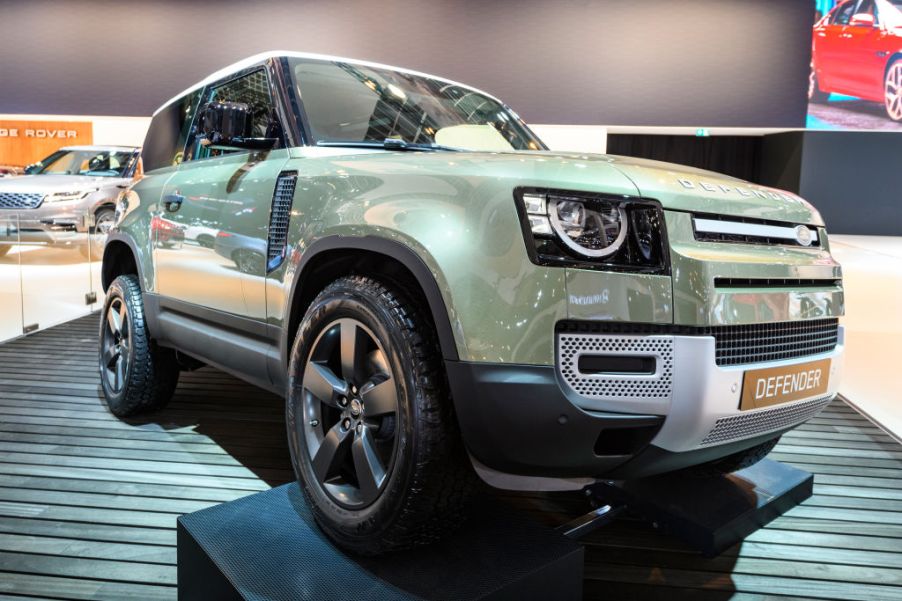
Off-Roading Is a Breeze in the New 2020 Land Rover Defender
The auto world was in shock when Land Rover made the decision to discontinue the legendary Defender in 2016. It was a shocking move that did little to help Land Rover build its brand. Then rumors began to hit the web about how the Land Rover Defender was being fully redesigned, and the internet was filled with rumors about how the all-new Defender would look.
We now have the details. MotorTrend recently took the new Defender out for a ride on the Western Coast of Africa, and here’s what they had to say.
What’s new for the 2020 Land Rover Defender?
The Land Rover Defender has been around the block—or mountain in this case—quite a few times, and Land Rover knows what it takes to build a great off-road vehicle. According to Kelley Blue Book, there were some changes made, such as the unibody D7x platform that will have many off-roaders scratching their heads, but the Defender is now able to do more and do it more comfortably.
The body has the boxy look well-known for most off-road SUVs, yet it doesn’t look like the Jeep Wrangler and the Mercedes G-Class. It has a roof rack perfect for carrying cargo that won’t fit inside, and the spare tire on the back leaves more room for cargo inside.
The Defender has 11.5-inch ground clearance, optional air springs, and offers a smooth ride both on and off-road that the Wrangler is sorely lacking. The 2.0-liter turbocharged inline-4 standard engine has 296 hp. There is also a hybrid powertrain with an eight-speed automatic transmission. If that’s not good enough, 4WD also comes standard.
The inside is built for comfort, so drivers don’t feel each and every bump while traveling over the mountain and through the river. A ground-view camera is especially helpful as drivers can avoid obstacles that might leave them stranded if not avoided.
The price for the new Land Rover Defender will start at $49,900 for the base 110 model. From there, the price climbs all the way up to $80,900 for the X trim level. Other off-road vehicles cost significantly less unless it’s the G-Class, but this Land Rover has much better ride quality and offers a lot of technology.
The desert test
When testing a new off-road vehicle, there are tons of places reviewers can go. For more casual off-road vehicles, it may be tested in a small park. Then there are vehicles like the Jeep Wrangler, the Toyota 4Runner, the Mercedes G-Class, and the Land Rover Defender that are designed for more serious off-roading. These are often taken to either the mountains or the desert. In this case, MotorTrend headed straight for the deserts of Africa.
The exact location was Namibia. It’s the second-least populated location in the world, meaning that if things went wrong, the MotorTrend team was essentially on their own. Namibia is as large as Texas and Arkansas combined, so this test was as real as it gets.
As the MotorTrend team traveled over 500 miles, they put the Land Rover Defender through its paces. After dodging goats as they left civilization, the team got to adjust to the Defender’s capabilities. The steering was incredibly easy, while the engine—which tended to lag—took a little getting used to.
The next day, the trip got a lot more serious. MotorTrend reports, “Linking the inland to the Marienfluss Valley, the pass was cut haphazardly by a Dutch explorer, a Ford Model T, and a hundred Himba in the 1960s. It first climbs up to about 4,000 feet before dropping 2,000 feet via a 35-degree slope into the Marienfluss. Slick with loose rock and steep drop-offs, the jagged path is punctuated with carcasses of Toyota Hiluxes that had gone over the side.”
The team traveled over a rapidly changing terrain that switched between sand and rock with little warning. The Defender’s terrain response system, which can detect changing terrain and adjust without waiting for the driver to catch up, was a real boon. The team also crossed the Hoarusib River.
The Land Rover Defender thrives off the pavement

Overall, the Land Rover Defender went above and beyond all that was promised. It does rely heavily on technology, so some off-roaders may feel like it’s not a true off-road vehicle. Other drivers may welcome the technology as they can go more places with more confidence.


